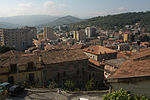Agropoli
You can help expand this article with text translated from the corresponding article in Italian. (January 2022) Click [show] for important translation instructions.
|
Agropoli | |
|---|---|
| Comune di Agropoli | |
 Panoramic view | |
 Agropoli within the Province of Salerno | |
UTC+2 (CEST) | |
| Postal code | 84043 |
| Dialing code | 0974 |
| Patron saint | Sts. Peter and Paul |
| Saint day | June 29 |
| Website | Official website |
Agropoli is a town and comune located in the Cilento area of the province of Salerno, Campania, Italy. It is situated at the start of the Cilentan Coast, on the Tyrrhenian Sea.
History
Pre-medieval period
The promontory on which Agropoli stands has been inhabited since Neolithic times. It seems, however, that it was not until the later Bronze and Iron Ages that it came to be continuously inhabited by a stable, indigenous population, which lived off hunting and fishing.
To the east of the promontory, at the mouth of the
of Hunting.It has been established that in
Medieval period
During the 5th century, when the Vandals made life difficult in Ercula, its inhabitants retreated to the overlooking promontory, which offered better prospects for defence. Then, in the 6th century, during the Greco-Gothic war (535-553), the Byzantines needed a secure, well-protected harbour, south of Salerno, so they fortified it, and called it Acropolis, meaning 'high town' or citadel. Acropolis remained in the hands of the Byzantines until 882, when the town fell to the
For the rest of the medieval period, the area remained under the protection of the bishops, who also possessed huge territories, including the inhabited areas of
Modern period
The first statistics on Agropoli were compiled in 1445, when the town, including its dependent villages, had a total of 202 homes and, therefore, a similar number of families. Apart from a few changes, such as the temporary transfer to Rodrigo d'Avalos, Marquis of Vasto, from 1505 to 1507, Agropoli and its feudal lands were held by the Sanseverino family until 1552, when Prince Ferrante was accused of treason, and forced to give up all his possessions. After that, Agropoli passed to various families in succession:
- D'Ayerbo of Aragon (1553)
- Grimaldi (after 1564)
- Arcella Caracciolo (1597)
- Mendoza (1607)
- the Filomarino princes of Roccadaspide (1626)
- Mastrillo (1650)
- Zattara
- the Sanfelice, Dukes of Laureana (1660), who possessed the town until the abolition of feudalism in 1806.
Agropoli was a particular target of raids from
During the 19th century, Agropoli began to expand outside the medieval walls, but the old town has remained intact, together with most of the surrounding defensive walls, and the 7th-century entrance gate.
Geography
The municipality borders with
It includes the hamlets (
Main sights
This section is written like a encyclopedic style or move the content to Wikivoyage . (January 2022) |

The town, where some tombs predating the Byzantine period were recently found, also houses the medieval ruins of San Francesco's monastery, and the Churches of the Holy Mary of Constantinople (16th century), San Marco, and San Francesco. The beaches of Trentova Bay contribute to make Agropoli an important seaside resort.
The Angevin-Aragonese castle, which was built on the 6th century Byzantine foundations, still stands on top of the promontory. It has a triangular plan with three circular towers and a moat. To the west of the modern tourist harbour is another small promontory, on which the coastal tower of San Francesco (16th century) stands next to the much altered remains of the convent of the same name.
In the Municipal Antiquarian, there is a sizeable collection of archaeological finds, representing life in the area from prehistoric to medieval times.
Transportation
Agropoli has a train station on the Salerno–Reggio di Calabria railway. Road connection is guaranteed by the State highway SS18, which joins with the A2 Motorway at Battipaglia.
Agropoli has also a large tourist port, connected by ferries to Capri, Ischia, Salerno and Naples.
Sports
One of the companies of Athletic is the ASD Agropoli Running, founded on October 26, 2011.[4]
Titular see
Agropoli is a titular see of the Catholic Church. It has been the title of:
- Zenon Grocholewski (21 December 1982 – 21 February 2001)
- Marc Ouellet (3 March 2001 – 15 November 2002)
- Pedro López Quintana (6 January 2003 – present)
Note: Pope Paul VI named John Paul Elford titular bishop of Agropoli in 1968,[5] but Elford declined the appointment.[6]
Gallery
-
Old town seen from the coast
-
A road in the old town
-
Aragonese Castle
-
Panoramic view
Twin towns
 Chili, New York, United States
Chili, New York, United States
See also
- Cilentan dialect
- Cilentan Coast
- Cilento and Vallo di Diano National Park
References
- ^ "Superficie di Comuni Province e Regioni italiane al 9 ottobre 2011". Italian National Institute of Statistics. Retrieved 16 March 2019.
- Istat2011
- ^ (in Italian) US Agropoli website Archived June 22, 2012, at the Wayback Machine
- ^ (in Italian) Agropoli Running website
- ^ "Coadjutor, two auxiliaries named by Pope Paul". Catholic News Service. 24 July 1968. Retrieved 11 January 2021.
- ^ "Bishopric Declined in Indiana". The Catholic Advocate. October 31, 1968. Retrieved January 11, 2021.
External links
- Official website (in Italian)
- Photo Album of Agropoli Archived 2012-03-03 at the Wayback Machine
- Agropoli on cilento-travel.com Archived 2016-03-13 at the Wayback Machine





